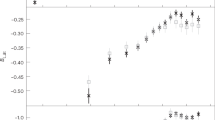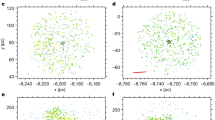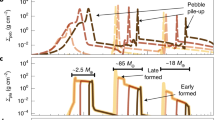Abstract
M. W. OVENDEN1 has outlined a theory intended to provide a dynamical explanation for Bode's Law. I suggest instead that the approximately constant spacing ratio expressed in Bode's mnemonic can be generated by a sequence of random numbers subject to the constraint that adjacent planets cannot be “too close to each other”. The physical basis for the constraint is that if in the process of accretion two planets were “too close to each other”, they would coalesce or cease to grow because they were competing for the same material. Such a constraint was embodied in a series of computer-generated planetary systems published by S. H. Dole2. Dole generated planets by injecting nuclei into a Laplace-type nebula and allowing them to accrete dust and also gas (if their mass was sufficiently large and their temperature sufficiently low). He kept track of the dust and gas accreted (so that it could not be used twice) and coalesced planets if their orbits crossed. The initial semimajor axes of the proto-planets were chosen at random.
This is a preview of subscription content, access via your institution
Access options
Subscribe to this journal
Receive 51 print issues and online access
$199.00 per year
only $3.90 per issue
Buy this article
- Purchase on Springer Link
- Instant access to full article PDF
Prices may be subject to local taxes which are calculated during checkout
Similar content being viewed by others
References
Ovenden, M. W., Nature, 239, 508 (1972).
Dole, S. H., Icarus, 13, 494 (1970).
Author information
Authors and Affiliations
Rights and permissions
About this article
Cite this article
LECAR, M. Bode's Law. Nature 242, 318–319 (1973). https://doi.org/10.1038/242318a0
Received:
Issue Date:
DOI: https://doi.org/10.1038/242318a0
This article is cited by
-
Exponential distance relations in planetary-like systems generated at random
Earth, Moon, and Planets (1988)
-
Lois exponentielles de distance pour les systèmes de satellites
Earth, Moon, and Planets (1986)
-
The missing planet
The Moon and the Planets (1978)
-
The Titius-Bode law-place for more than ten planets?
Celestial Mechanics (1977)
Comments
By submitting a comment you agree to abide by our Terms and Community Guidelines. If you find something abusive or that does not comply with our terms or guidelines please flag it as inappropriate.



